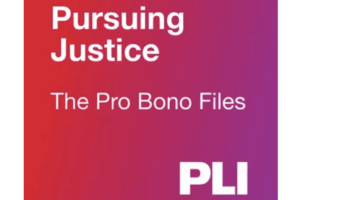 This glacially paced discussion of résumés continues with today’s fourth installment. Having given an overview, discussed headers, and then the education section, it is time to move onto the résumé section that will likely become dominant as your legal career unfolds, your work experience.
This glacially paced discussion of résumés continues with today’s fourth installment. Having given an overview, discussed headers, and then the education section, it is time to move onto the résumé section that will likely become dominant as your legal career unfolds, your work experience.
The structure and overall look of this section should be similar to that of the education section. Entries should be listed in inverse chronological order so that your most recent position is listed first. However, there is a wrinkle here which does not likely present itself in the education section. In many instances — especially with wages in this country having been stagnant for the last several decades — a person will find themselves working multiple jobs at the same time. This does not present an issue — other than abject fatigue — if one starts working at Job A and Job B at the same time and concludes their employment simultaneously. But that is typically not how this scenario plays out. Instead, a person typically starts one job, and then a second, and then that second job might end before the first one concludes. So how should these be positions be arranged in one’s experience section? There are two ways to approach it, either arrange them chronologically by the start date or by the end date. Personally, I prefer the latter, since the individual reviewing your résumé is going to read from the top of your résumé down, but either way is fine so long as you are consistent.
Speaking of dates, I have seen a variety of methods employed by students and experienced attorneys to express the period of time they were working in a particular position. Some list just the years, while others modify the year with either the month their employment began and ceased or the season, with the latter being more popular for positions held while in school. Which is correct? Again, there is no absolute rule that one must follow, instead, the key is to be consistent. You cannot have one job listed as running from 2015 — 2016,[1] the next as February 2016 — March 2017, and the final as Spring 2018. Pick one style and run with it. In my experience, the month year formulation is the most popular, but as previously discussed in this space, there are few things on a résumé more damaging to employment prospects than a time gap, i.e., a period where your résumé indicates you were not doing anything. If such a gap exists in your background, then merely listing the year for your various work entries can possibly paper over some of the time void.

Chrometa: Turning Time Into Billable Value For Modern Lawyers
Adoption of Chrometa represents more than a technological upgrade; it reflects a professional philosophy that values accuracy, transparency, and efficiency.
While dates are important, for each entry in the experience section, you will actually need to explain what it is you did each and every day. If there is a problem formulating this section, just think in terms of how you would answer the Bobs.

Use action words and try not to be repetitive. Never lie, but feel free to use a bit of flourish when explaining what you might think to be mundane tasks. Answering telephones can become “liaising with key stakeholders.” Waiting tables is perhaps better described as being the organization’s forward facing imagine during regular interaction with clients. Do not spend time and digital ink explaining the business model of a particular organization. If a legal employer really wants to know what sorts of products are created by Smith, Inc., or how much revenue it generates yearly, they can look up that information. Furthermore, use this section to discuss the skills you developed on the job, rather than the internal metrics or financial targets that were met. Your average Biglaw firm is going to be far more interested in the research skills developed in a non-legal job than they are if your division moved an extra 10,000 widgets.
And while I am relatively flexible when it comes to the experience section,[2] a hard and fast personal rule is that bullet points have no place in one’s résumé, especially in the experience section, where they are most likely to wreak havoc. Granted, this rule is one that can be a point of vehement disagreement, but for me the simple reason for this stance is that a résumé has a finite amount of space and one’s goal should be to fit as much material in as small of an area as possible. Bullet points are antithetical to this goal since they take up a good amount of white space and force you to take up at least a line for each point you want to express. Instead, list your job duties in sentences or even sentence fragments, each separated by a semicolon, but looking like a paragraph.

Pursuing The Pro Bono Story: A Conversation With Alicia Aiken
This Pro Bono Week, get inspired to give back with PLI’s Pursuing Justice: The Pro Bono Files, a one-of-a-kind podcast hosted by Alicia Aiken.
How about if you have held multiple positions in the same organization over a period of time? Showing that you have been promoted, even with non-legal employers, is likely going to be of great interest to legal employers, since it is evidence you can excel in a professional setting. Rather than repeat the organization heading — [Name of Organization], [City], [State Postal Abbreviation or Foreign Country, whichever is applicable] — just create a new entry for each title under the same organization heading. The difference is that the space between different titles held in an organization should be separated by a space that is half the size of the spacing between different jobs held with different organizations.
Finally, what about jobs that have been secured, but have not yet commenced. Say you have secured a clerkship with a Supreme Court justice for the upcoming Court term. Great! Say it’s with the justice most recently credibly accused of sexual assault. Less great. Say that it is with the same justice your mother bent over backward to defend during a highly contentious confirmation process — what with the aforementioned credible allegation of sexual assault — while laughably claiming that you would not be able to clerk for this then judge if he joined SCOTUS.

But if you want to ignore the illicit fruit from the triumph of elite clannishness, go ahead and list the position as you would any other entry in your experience section, but instead of a job description, just list “anticipated” followed by the applicable dates.
So how should a work experience entry look like with all these rules in mind, something like:
Smith, Smith & Jones, Anytown, TN
Summer Associate: Conducted legal research and drafted memoranda on a range of federal constitutional issues including the Third Amendment; assisted in preparation for civil and criminal trials; liaised with clients. May – August 2019
This clearly and succinctly allows you to express to a potential employer what it is you actually did in your previous professional stops.
[1] While there are not many hard and fast formatting rules in this section of a résumé, the use of an em dash, with a space on either side, to separate dates is a hill I am ready to die on today and every subsequent day going forward.
[2] But see, supra note 1.
Nicholas Alexiou is the Director of LL.M. and Alumni Advising as well as the Associate Director of Career Services at Vanderbilt University Law School. He will, hopefully, respond to your emails at [email protected].